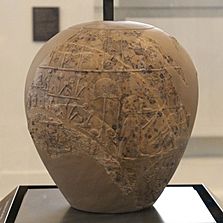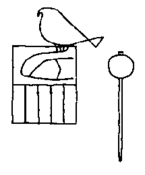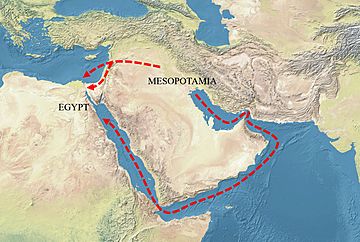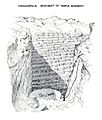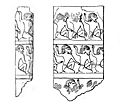Scorpion II facts for kids
Quick facts for kids Scorpion |
|
|---|---|
| Weha, Selk | |
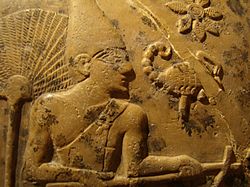
King Scorpion II shown on the Scorpion Macehead at the Ashmolean Museum.
|
|
| Pharaoh | |
| Reign | Uncertain (Dynasty 0) |
| Predecessor | Ka? |
| Successor | Narmer? |
Scorpion II (in Ancient Egyptian: maybe called Selk or Weha), also known as King Scorpion, was a ruler in the early period of Upper Egypt (around 3200–3000 BCE). Upper Egypt was the southern part of ancient Egypt.
Contents
Who Was King Scorpion?
What Was His Name?
Scholars still discuss the exact name and title of King Scorpion today. His name often appears with a special golden flower sign. This sign was used on many items from the time of Dynasty 0 and Dynasty I. It later disappeared but came back for important officials in the Third Dynasty.
People have debated what the golden flower sign means. Most think it meant 'leader' or 'high lord'. In early times, it was used for kings. Later, it was given to important officials and princes, especially those who served the goddess Seshat. So, the golden flower became a symbol of Seshat.
The scorpion animal often stood for dangerous things like 'poison' or 'illness'. It could also mean 'storm' or 'attack' in war. Because we are not sure what the scorpion symbol meant for King Scorpion II, scholars usually just call him 'King Scorpion II'.
Was He a Real King?
There are different ideas about who King Scorpion II was and when he ruled. Some experts, like Bernadette Menu, believe that Scorpion was the same person as Narmer. They think kings in the First Dynasty had many names. They also point out that the art style on Scorpion II's macehead looks very similar to the famous Narmer macehead.
Other scholars, including T. H. Wilkinson and Renée Friedman, think King Scorpion II was a rival ruler to Narmer and Ka. At the time of Scorpion II, Egypt was split into several small kingdoms that fought each other. It is thought that Narmer simply defeated Ka and Scorpion II. This led to Narmer uniting all of Egypt for the first time.
What We Know About Him
The Scorpion Macehead
The only picture we have of King Scorpion II is on a special object called the Scorpion Macehead. This macehead was found by archeologists James E. Quibell and Frederick W. Green. They found it in a temple at Nekhen (Hierakonpolis) in 1897–1898. Today, you can see it at the Ashmolean Museum in Oxford. Experts believe it was made at the very end of the time before the dynasties began.
The Scorpion Macehead shows a large figure wearing the White Crown of Upper Egypt. He is holding a hoe. This might show the pharaoh doing a special ceremony. He could be cutting the first furrow in the fields or opening canals to flood them. This scene is similar to how Narmer is shown on the Narmer Palette.
In front of the king are servants. One servant seems to be throwing seeds into the newly dug ground. Another servant (partially damaged) carries a big bundle of grain. This makes it seem like a seed-sowing ceremony. It might be linked to the Sed festival or a founding ceremony. Perhaps Scorpion II founded Nekhen or Buto, which would explain why the macehead was found in Hierakonpolis.
Above the servants, there is a line of standard bearers. They carry the same standards seen on the Narmer palette. Below the servants, you can see a road and a landscape with people and houses.
Behind the king, two fan bearers follow him. To the left of the fan bearers, there are bundles of papyrus plants. Behind these, in the upper part, you can see dancers and a priest. The priest is guarding a special palanquin. The lower part of the scene is damaged. The festive parade faces the opposite direction from the king. This means both processions meet in the middle of the macehead relief.
In the very center, scholars believe they see tiny marks of feet and the coil of the Red Crown. A second golden flower sign is also clearly visible. These marks suggest that the Scorpion macehead once showed a second image of the king. This second image would have shown him wearing the Red Crown of Lower Egypt. If this is true, the macehead would show King Scorpion II as the ruler of all of Egypt.
The very top scene on the macehead shows a row of divine standards. Each standard has a god (like Set, Min, and Nemty) or a symbol of a region. We don't know the exact number of standards. But it is clear that one half shows hanged lapwings, and the other half shows hanged hunting bows. Both rows of standards face each other. Lapwings stood for 'Lower Egyptian people' or 'common people'. The bows stood for 'people of archers', meaning hostile Asian tribes. Their hanging suggests that Scorpion II started attacks on Lower Egypt and enemies near the borders. These attacks eventually led to Narmer's victory and the unification of the country.
Ivory Tags
Many small ivory tags with scorpion pictures have been found. They come from Abydos, Minshat Abu Omar, and Tarkhan. Some tags show the scorpion holding a hieroglyphic sign for "land" or "garden." It is debated if this means the scorpion represents King Scorpion II as a ruler of a certain region. Other tags show the scorpion near a swallow sign, which means 'the scorpion is great'. One special tag shows the scorpion holding a long stick, hitting an enemy. Since many tags have a shrine with a heron on the back, some think Scorpion II came from Buto.
Rock and Vessel Writings
At Tarkhan and Minshat Abu Omar, several stone and clay pots were found. They have royal serekhs carved into them. The name inside is debated. Some Egyptologists believe the serekhs show a very simple picture of a scorpion. Others are not so sure and think it is a poorly drawn version of King Ka's name.
Near the second cataract of the Nile, close to the Nasser-reservoir in Sudan, there is a large rock carving. It shows a big scorpion figure walking over dead enemies. Their death is shown by them being upside-down and hit by arrows. Two other figures are still holding their bows and shooting. Because of the ostrich feathers and bows, these enemies are identified as Nubians. The scorpion faces a human figure with a fake beard and a ceremonial knife. This figure holds a long rope with captured Nubians tied to it. This whole scene is thought to show King Scorpion II celebrating his victory against the Nubians.
His Time as Ruler
How Was Egypt Ruled?
Many ancient objects with carvings and pottery marks show that trade was strong during Scorpion's rule. For the first time, writings show hieroglyphs for 'Lower Egypt' and 'Upper Egypt'. This means both parts of Egypt slowly started to work together.
Since Egypt was divided into at least two kingdoms, scholars wonder how these early kings kept their power. Wars and conquests needed money and supplies. Warriors and guards had to be fed. Experts believe that the kings' power came from the large irrigation systems they built. These systems helped control water for farming.
Many ancient palettes and the maceheads of Scorpion II and Narmer show rivers, plants, trees, and animals in great detail. Alongside these, human figures doing farm work are shown. Scholars think that these farming improvements were the source of power for the early kings. Irrigation systems allowed more settlements, more cattle, and more crops. Some wonder if the kings kept the irrigation systems limited on purpose to keep their power and wealth.
Religion and Beliefs
The many decorations on ancient objects also show many standards with gods on top. This tells us that religion and worship were already very complex. Since the standards often appear in battle scenes, battles might have been seen as religious events too. The earliest gods we can recognize are Horus, Seth, Min, Nemty, Nekhbet, Bat, and Wepwawet. But we don't know where these gods had their main places of worship, because hieroglyphs for place names were not used yet.
Another part of beliefs during Scorpion II's time are the many pictures of mythical creatures. These include the 'serpopard' and the 'winged chimera'. The "serpopard" (also called "snake neck panther") appears on the famous Narmer palette. It was called Swdja, meaning "undestroyable." In Egyptian stories, the serpopard was said to "move the sun." On the Narmer palette, two serpopards have their necks twisted together. This picture is thought to be a symbol of Egypt's unification. Under Scorpion II, two serpopards are tearing apart a gazelle. This might mean the serpopards were controlled by the king.
The "winged chimeras" were called Sefer in Egyptian. They stood for chaos and violence. They appear on other ancient objects. Scholars point out that creatures like the chimera and serpopards came from Mesopotamia.
Another symbol from Scorpion's time that clearly came from Mesopotamia is a warrior fighting two lions with his bare hands. He holds one lion in each hand. A similar picture shows the warrior with two giraffes. Later, this symbol became a hieroglyph. It was used as the symbol for the city of Cusae.
Influences from Mesopotamia
All the symbols and items mentioned, along with tomb building styles and traded goods (like tools and cylinder seals), show a surprisingly strong influence from Mesopotamian culture and religion on early Egyptians. This idea is supported by looking at how tombs were built in places like Minshat Abu Omar, Hierakonpolis, and Naqada. The ways of building strong tombs were clearly copied from Mesopotamian buildings.
It is not fully clear why Egyptians had such a close relationship with Mesopotamia. Some older theories suggested that the first Egyptian leaders came from Mesopotamia. However, modern scholars no longer believe this.
Today, most scholars think that Egyptian civilization grew from the African people living in the Nile Valley. They believe that the evidence strongly supports an African origin for the ancient Egyptians. During the rule of King Scorpion II and the kings right after him, the Mesopotamian influence seems to lessen. Egypt then began to develop its own, more unique culture. This was an important step for Egypt to become a powerful and wealthy kingdom.
Images for kids
-
Hierakonpolis revetment of Temple basement
Where Is His Tomb?
The exact burial place of Scorpion II is unknown. There are two tombs that might be his. The first is called Tomb B50 and is at Umm el-Qa'ab (near Abydos). It is a square-shaped room divided into four parts by a mud wall. Several ivory tags with scorpion figures were found here. The second possible tomb is at Hierakonpolis, called Tomb HK6-1. It is about 3.5 meters by 6.5 meters, 2.5 meters deep, and made stronger with mud. Several ivory tags with scorpion figures were also found here.
See also
 In Spanish: Horus Escorpión II para niños
In Spanish: Horus Escorpión II para niños


